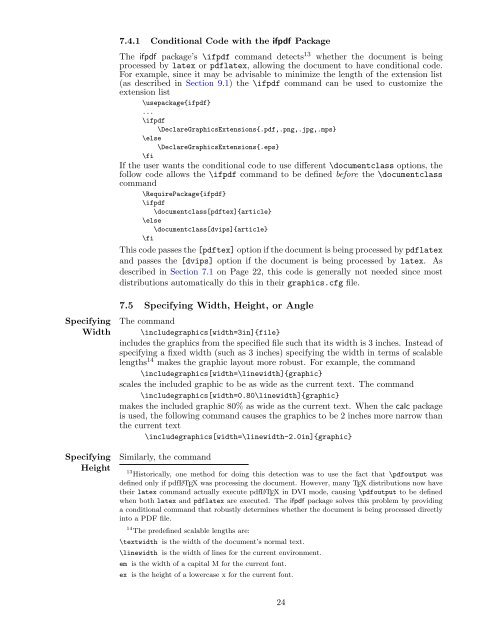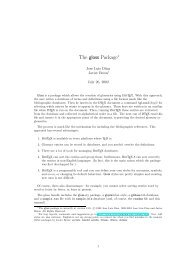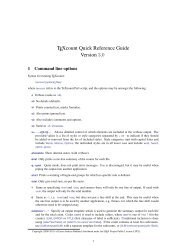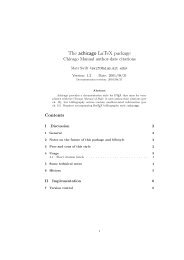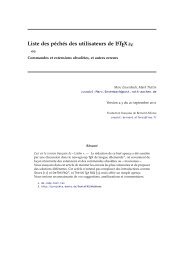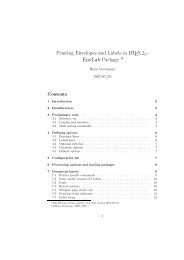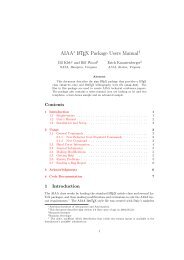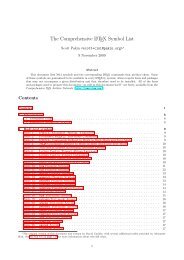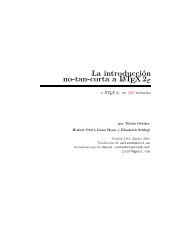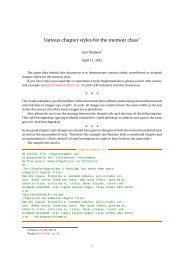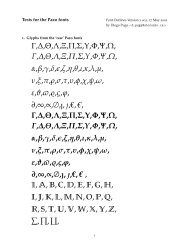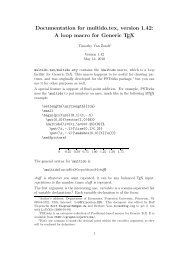Using Imported Graphics in LaTeX and pdfLaTeX - Mirror
Using Imported Graphics in LaTeX and pdfLaTeX - Mirror
Using Imported Graphics in LaTeX and pdfLaTeX - Mirror
Create successful ePaper yourself
Turn your PDF publications into a flip-book with our unique Google optimized e-Paper software.
7.4.1 Conditional Code with the ifpdf Package<br />
The ifpdf package’s \ifpdf comm<strong>and</strong> detects 13 whether the document is be<strong>in</strong>g<br />
processed by latex or pdflatex, allow<strong>in</strong>g the document to have conditional code.<br />
For example, s<strong>in</strong>ce it may be advisable to m<strong>in</strong>imize the length of the extension list<br />
(as described <strong>in</strong> Section 9.1) the \ifpdf comm<strong>and</strong> can be used to customize the<br />
extension list<br />
\usepackage{ifpdf}<br />
...<br />
\ifpdf<br />
\Declare<strong>Graphics</strong>Extensions{.pdf,.png,.jpg,.mps}<br />
\else<br />
\Declare<strong>Graphics</strong>Extensions{.eps}<br />
\fi<br />
If the user wants the conditional code to use different \documentclass options, the<br />
follow code allows the \ifpdf comm<strong>and</strong> to be def<strong>in</strong>ed before the \documentclass<br />
comm<strong>and</strong><br />
\RequirePackage{ifpdf}<br />
\ifpdf<br />
\documentclass[pdftex]{article}<br />
\else<br />
\documentclass[dvips]{article}<br />
\fi<br />
This code passes the [pdftex] option if the document is be<strong>in</strong>g processed by pdflatex<br />
<strong>and</strong> passes the [dvips] option if the document is be<strong>in</strong>g processed by latex. As<br />
described <strong>in</strong> Section 7.1 on Page 22, this code is generally not needed s<strong>in</strong>ce most<br />
distributions automatically do this <strong>in</strong> their graphics.cfg file.<br />
Specify<strong>in</strong>g<br />
Width<br />
Specify<strong>in</strong>g<br />
Height<br />
7.5 Specify<strong>in</strong>g Width, Height, or Angle<br />
The comm<strong>and</strong><br />
\<strong>in</strong>cludegraphics[width=3<strong>in</strong>]{file}<br />
<strong>in</strong>cludes the graphics from the specified file such that its width is 3 <strong>in</strong>ches. Instead of<br />
specify<strong>in</strong>g a fixed width (such as 3 <strong>in</strong>ches) specify<strong>in</strong>g the width <strong>in</strong> terms of scalable<br />
lengths 14 makes the graphic layout more robust. For example, the comm<strong>and</strong><br />
\<strong>in</strong>cludegraphics[width=\l<strong>in</strong>ewidth]{graphic}<br />
scales the <strong>in</strong>cluded graphic to be as wide as the current text. The comm<strong>and</strong><br />
\<strong>in</strong>cludegraphics[width=0.80\l<strong>in</strong>ewidth]{graphic}<br />
makes the <strong>in</strong>cluded graphic 80% as wide as the current text. When the calc package<br />
is used, the follow<strong>in</strong>g comm<strong>and</strong> causes the graphics to be 2 <strong>in</strong>ches more narrow than<br />
the current text<br />
\<strong>in</strong>cludegraphics[width=\l<strong>in</strong>ewidth-2.0<strong>in</strong>]{graphic}<br />
Similarly, the comm<strong>and</strong><br />
13 Historically, one method for do<strong>in</strong>g this detection was to use the fact that \pdfoutput was<br />
def<strong>in</strong>ed only if pdfL A TEX was process<strong>in</strong>g the document. However, many TEX distributions now have<br />
their latex comm<strong>and</strong> actually execute pdfL A TEX <strong>in</strong> dvi mode, caus<strong>in</strong>g \pdfoutput to be def<strong>in</strong>ed<br />
when both latex <strong>and</strong> pdflatex are executed. The ifpdf package solves this problem by provid<strong>in</strong>g<br />
a conditional comm<strong>and</strong> that robustly determ<strong>in</strong>es whether the document is be<strong>in</strong>g processed directly<br />
<strong>in</strong>to a pdf file.<br />
14 The predef<strong>in</strong>ed scalable lengths are:<br />
\textwidth is the width of the document’s normal text.<br />
\l<strong>in</strong>ewidth is the width of l<strong>in</strong>es for the current environment.<br />
em is the width of a capital M for the current font.<br />
ex is the height of a lowercase x for the current font.<br />
24


